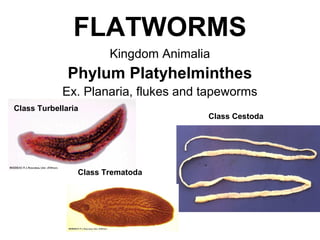
Phylum platyhelminthes
- 1. FLATWORMS Kingdom Animalia Phylum Platyhelminthes Ex. Planaria, flukes and tapeworms Class Cestoda Class Turbellaria Class Trematoda
- 2. Characteristics of Platyhelminthes • Body symmetery: bilateral • Body organization: triploblastic (3 layers) – Ectoderm – Mesoderm (first!!) – Endoderm • Body Cavity: acoelomate
- 4. Characteristics continued • Digestive system: mouth & gastrovascular cavity • Reproduction: – Sexual: hermaphroditic – cross fertilization occurs between 2 worms – Asexual: fragmentation
- 5. Characteristics continued: • Circulation: diffusion • Nervous system: – Cephalization (first) & nerves – Eyespots, auricles, sensitive to light & chemicals • Respiration: diffusion through skin • Excretion: tubes open to outside, flame cells (rid of excess H2O)& mouth • Habitat: host (intestine) & freshwater
- 7. • Ecological roles: – Parasitic – Food source – Eat dead animals • saprophytes
- 8. Additional information: Free living ex) Planaria – freshwater Stores food as fat Brain coordinates movement & capable of learning its way through a maze Able to respond to light & chemicals
- 9. Additional information: Parasitic Ex) flukes and tapeworms • Lives in digestive tract & absorbs digested food from host so, NO digestive tract! • This leaves more room for reproduction – capable of producing 1,000s of eggs.
- 10. Platyhelminthes vs Cnidarians • Tissues organized into organs – Reproductive system (organized organs) • Three embryonic tissue layers – Mesoderm • Bilateral Symmetry • Cephalization and nerve cords • No true organs • Two Tissue layers • Radial Symmetry • Nerve Net **DO NOT COPY
- 11. Class Cestoda • AKA tapeworms • Tapeworms are parasites that live in the digestive system of vertebrate animals
- 12. More on Tapeworms… • Specialized for living within a host – Lost most body systems • No digestive, nervous, excretory, muscle systems • Absorb food by diffusion through skin – Has specialized reproduction
- 13. Tapeworm Reproduction • Specialized body sections called proglottids – Hermaphroditic • Contain both ovaries and testes • Can fertilize their own eggs – Zygotes are passed out of host’s body with feces – Larvae hatch in water and in grass • Eaten by herbivore (intermediate host) – larvae then burrows through wall of intestine and into blood stream • Intermediate host contains tapeworm cysts (bladder worm)– when ingested by final host (e.g. human) cyst hatches out as scolex which then grows proglottids **DO NOT COPY**
- 14. Tapeworm cont’d • Two body regions – Scolex – “head” • No cephalization • Hooks and suckers used to attach to inside wall of intestine – Proglottids • Body segments for reproduction
- 19. Fun Facts About Tapeworms • Some tapeworms grow quite long. One species that parasitizes horses has been known to attain a length of 75 feet. • Ingesting tape worms for reducing weight is a diet routine: A rather surprising fact about tape worms is that ingesting them as a weight-loss technique is happening even in these modern times. The person undergoing this method has the direct risk of an infection. It also causes a dramatic reduction in the body’s ability to absorb nutrients; and a counter-effect, where the person eats more to balance the metabolic stress once the diet regime is over. **DO NOT COPY**
- 20. Class Trematoda Ex: Chinese liver fluke
- 21. Fluke (liver, lung, heart, intestine) • Parasitic – Pharynx swallows host’s tissue and body fluids (including blood) – Common intermediate host: raw fish • No need for circulation or respiratory system – Live in tissues supplied by host’s blood – Absorb through gastrovascular cavity • Flame cells • Nerve cords and anterior ganglia – Do not have as specialized nerve cells like Planaria • Hermaphrodites – Complex life cycle with numerous larval stages that infect a number of hosts.
- 22. Liver Fluke Life Cycle
- 23. Blood Flukes
- 24. liver fluke
- 26. Planaria • Excretion – Two networks of tubes – Attached to tubes are flame cells • Modified to work like a kidney • Have cilia that cause excess body fluid to move along excretory tubes and eventually out of planaria body • Muscles – Three layers of muscles below ectoderm – Constrict – shorten, and flatten worm.
- 27. Flame Cell 1. Cell Nucleus 2. Bundle of Cilia (flame) 3. Parenchyma Tissue 4. Collecting Duct
- 29. 1. Pharynx 2. Auricle 3. Eye spot 4. Pharynx 5. Gastrovascular cavity
- 30. Marine Flatworms
- 31. Flatworms are hermaphrodites When flatworms encounter each other, they engage in a 60 minute ‘dance’ during which they repeatedly strike at each other, both trying to inject their sperm under the skin of the other worm. The ‘winner’ becomes the male for that encounter, and the ‘loser’ must become the female & care for the fertilized eggs! https://www.youtube.com/watch?v=wn3xluIRh1Y
Editor's Notes
- Longest human tapeworm = 12 meters long Longest tapeworm = 40 meters long “platy” means flat “helminthes” greek for worm
- Protostome – one cavity that is a mouth
- Nephridia are more evolved than flame cells because they can reabsorb useful metabolites before excretion of waste. Both nephridia and flame cells are ciliated tubules that filter fluids in the cell to remove waste. Flame cells are connected to a duct system of pores to expel wastes, while nephridia often are open to the exterior of the organism. Source: Boundless. “Flame Cells of Planaria and Nephridia of Worms.” Boundless Biology. Boundless, 14 Nov. 2014. Retrieved 18 Dec. 2014 from https://www.boundless.com/biology/textbooks/boundless-biology-textbook/osmotic-regulation-and-excretion-41/excretion-systems-230/flame-cells-of-planaria-and-nephridia-of-worms-863-12110/